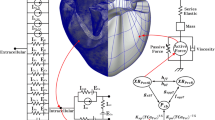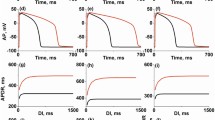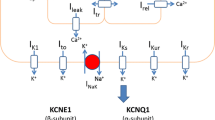Abstract
The understanding of cardiac arrhythmia under genetic mutations has grown in interest among researchers. Previous studies focused on the effect of the D172N mutation on electrophysiological behavior. In this study, we analyzed not only the electrophysiological activity but also the mechanical responses during normal sinus rhythm and reentry conditions by using computational modeling. We simulated four different ventricular conditions including normal case of ten Tusscher model 2006 (TTM), wild-type (WT), heterozygous (WT/D172N), and homozygous D172N mutation. The 2D simulation result (in wire-shaped mesh) showed the WT/D172N and D172N mutation shortened the action potential duration by 14%, and by 23%, respectively. The 3D electrophysiological simulation results showed that the electrical wavelength between TTM and WT conditions were identical. Under sinus rhythm condition, the WT/D172N and D172N reduced the pumping efficacy with a lower left ventricle (LV) and aortic pressures, stroke volume, ejection fraction, and cardiac output. Under the reentry conditions, the WT condition has a small probability of reentry. However, in the event of reentry, WT has shown the most severe condition. Furthermore, we found that the position of the rotor or the scroll wave substantially influenced the ventricular pumping efficacy during arrhythmia. If the rotor stays in the LV, it will cause very poor pumping performance.

A model of a ventricular electromechanical system. This whole model was established to observe the effect of D172N KCNJ2 mutation on ventricular pumping behavior during sinus rhythm and reentry conditions. The model consists of two components; electrical component and mechanical component. The electrophysiological model based on ten Tusscher et al. with the IK1 D172N KCNJ2 mutation, and the myofilament dynamic (cross-bridge) model based on Rice et al. study. The 3D electrical component is a ventricular geometry based on MRI which composed of nodes representing single-cell with electrophysiological activation. The 3D ventricular mechanic is a finite element mesh composed of single-cells myofilament dynamic model. Both components were coupled with Ca2+ concentration. We used Gaussian points for the calcium interpolation from the electrical mesh to the mechanical mesh.








Similar content being viewed by others
References
Adeniran I, El Harchi A, Hancox JC, Zhang H (2012) Proarrhythmia in KCNJ2-linked short qt syndrome: insights from modelling. Cardiovasc Res 94(1):66–76
Ambrosi D, Arioli G, Nobile F, Quarteroni A (2011) Electromechanical coupling in cardiac dynamics: the active strain approach. SIAM J Appl Math 71(2):605–621
Ambrosi D, Pezzuto S (2012) Active stress vs. active strain in mechanobiology: constitutive issues. J Elast 107(2):199–212
Anttonen O, Junttila M, Rissanen H, Reunanen A, Viitasalo M, Huikuri H (2007) Prevalence and prognostic significance of short QT interval in a middle-aged Finnish population. Circulation 116(7):714–720
Antzelevitch C, Pollevick GD, Cordeiro JM, Casis O, Sanguinetti MC, Aizawa Y, Guerchicoff A, Pfeiffer R, Oliva A, Wollnik B, et al. (2007) Clinical perspective. Circulation 115(4):442–449
Berenfeld O, Jalife J (1998) Purkinje-muscle reentry as a mechanism of polymorphic ventricular arrhythmias in a 3-dimensional model of the ventricles. Circ Res 82(10):1063–1077
Bernus O, Wilders R, Zemlin CW, Verschelde H, Panfilov AV (2002) A computationally efficient electrophysiological model of human ventricular cells. Am J Physiol Heart Circ Physiol 282(6):H2296–H2308
Bjerregaard P, Gussak I (2005) Short QT syndrome: mechanisms, diagnosis and treatment. Nat Rev Cardiol 2(2):84
CHEN PS, Garfinkel A, Weiss JN, Karagueuzian HS (1997) Spirals, chaos, and new mechanisms of wave propagation. Pacing and Clinical Electrophysiology 20(2):414–421
Cherubini C, Filippi S, Gizzi A, Ruiz-Baier R (2017) A note on stress-driven anisotropic diffusion and its role in active deformable media. J Theor Biol 430:221–228
Cherubini C, Filippi S, Nardinocchi P, Teresi L (2008) An electromechanical model of cardiac tissue: constitutive issues and electrophysiological effects. Prog Biophys Mol Biol 97(2-3):562–573
Clark DM, Plumb VJ, Epstein AE, Kay GN (1997) Hemodynamic effects of an irregular sequence of ventricular cycle lengths during atrial fibrillation. J Am Coll Cardiol 30(4):1039–1045
Clayton RH, Bailey A, Biktashev VN, Holden AV (2001) Re-entrant cardiac arrhythmias in computational models of long qt myocardium. J Theor Biol 208(2):215–225
Clayton RH, Holden AV (2002) Effect of regional differences in cardiac cellular electrophysiology on the stability of ventricular arrhythmias: a computational study. Phys Med Biol 48(1):95
Coronel R, Casini S, Koopmann TT, Wilms-Schopman FJ, Verkerk AO, de Groot JR, Bhuiyan Z, Bezzina CR, Veldkamp MW, Linnenbank AC, et al. (2005) Right ventricular fibrosis and conduction delay in a patient with clinical signs of Brugada syndrome: a combined electrophysiological, genetic, histopathologic, and computational study. Circulation 112(18):2769–2777
Costabal FS, Concha FA, Hurtado DE, Kuhl E (2017) The importance of mechano-electrical feedback and inertia in cardiac electromechanics. Comput Methods Appl Mech Eng 320:352–368
Courtemanche M, Ramirez RJ, Nattel S (1998) Ionic mechanisms underlying human atrial action potential properties: insights from a mathematical model. Am J Physiol Heart Circ Physiol 275(1):H301–H321
Da Un Jeong KML (2018) Influence of the KCNQ1 S140G mutation on human ventricular arrhythmogenesis and pumping performance: simulation study. Frontiers in Physiology 9
Echt DS, Liebson PR, Mitchell LB, Peters RW, Obias-Manno D, Barker AH, Arensberg D, Baker A, Friedman L, Greene HL, et al. (1991) Mortality and morbidity in patients receiving encainide, flecainide, or placebo: the cardiac arrhythmia suppression trial. New Engl J Med 324(12):781–788
El Harchi A, McPate MJ, hong Zhang Y, Zhang H, Hancox JC (2009) Action potential clamp and chloroquine sensitivity of mutant Kir2. 1 channels responsible for variant 3 short qt syndrome. J Mol Cell Cardiol 47(5):743–747
Franz MR, Cima R, Wang D, Profitt D, Kurz R (1992) Electrophysiological effects of myocardial stretch and mechanical determinants of stretch-activated arrhythmias. Circulation 86(3):968–978
Gallagher MM, Magliano G, Yap YG, Padula M, Morgia V, Postorino C, Di Liberato F, Leo R, Borzi M, Romeo F (2006) Distribution and prognostic significance of QT intervals in the lowest half centile in 12,012 apparently healthy persons. Am J Cardiol 98(7):933–935
Giantesio G, Musesti A, Riccobelli D (2019) A comparison between active strain and active stress in transversely isotropic hyperelastic materials. J Elast, pp 1–20
Giustetto C, Di Monte F, Wolpert C, Borggrefe M, Schimpf R, Sbragia P, Leone G, Maury P, Anttonen O, Haissaguerre M, et al. (2006) Short QT syndrome: clinical findings and diagnostic–therapeutic implications. Eur Heart J 27(20):2440– 2447
Gizzi A, Cherry E, Gilmour Jr RF, Luther S, Filippi S, Fenton FH (2013) Effects of pacing site and stimulation history on alternans dynamics and the development of complex spatiotemporal patterns in cardiac tissue. Front Physiol 4:71
Gizzi A, Cherubini C, Filippi S, Pandolfi A (2015) Theoretical and numerical modeling of nonlinear electromechanics with applications to biological active media. Commun Comput Phys 17(1):93–126
Gizzi A, Loppini A, Cherry E, Cherubini C, Fenton F, Filippi S (2017) Multi-band decomposition analysis: application to cardiac alternans as a function of temperature. Physiol Meas 38(5):833
Gizzi A, Loppini A, Ruiz-Baier R, Ippolito A, Camassa A, La Camera A, Emmi E, Di Perna L, Garofalo V, Cherubini C, et al. (2017) Nonlinear diffusion and thermo-electric coupling in a two-variable model of cardiac action potential. Chaos: An Interdisciplinary Journal of Nonlinear Science 27(9):093,919
Guilleminault C, Connolly SJ, Winkle RA (1983) Cardiac arrhythmia and conduction disturbances during sleep in 400 patients with sleep apnea syndrome. Am J Cardiol 52(5):490–494
Gurev V, Constantino J, Rice J, Trayanova N (2010) Distribution of electromechanical delay in the heart: insights from a three-dimensional electromechanical model. Biophys J 99(3):745–754
Gurev V, Lee T, Constantino J, Arevalo H, Trayanova NA (2011) Models of cardiac electromechanics based on individual hearts imaging data. Biomech Model Mechan 10(3):295–306
Gussak I, Bjerregaard P (2005) Short qt syndrome—5 years of progress. J Electrocardiol 38(4):375–377
Gussak I, Brugada P, Brugada J, Wright RS, Kopecky SL, Chaitman BR, Bjerregaard P (2000) Idiopathic short QT interval: a new clinical syndrome? Cardiology 94(2):99–102
Hansen DE, Craig CS, Hondeghem LM (1990) Stretch-induced arrhythmias in the isolated canine ventricle. evidence for the importance of mechanoelectrical feedback. Circulation 81(3):1094–1105
Hastings HM, Fenton FH, Evans SJ, Hotomaroglu O, Geetha J, Gittelson K, Nilson J, Garfinkel A (2000) Alternans and the onset of ventricular fibrillation. Phys Rev E 62(3):4043
Heikhmakhtiar AK, Rasyidin FA, Lim KM (2018) V241f kcnq1 mutation shortens electrical wavelength and reduces ventricular pumping capabilities: a simulation study with an electro-mechanical model. Front Phys 6:147
Heikhmakhtiar AK, Ryu AJ, Shim EB, Song KS, Trayanova NA, Lim KM (2018) Influence of LVAD function on mechanical unloading and electromechanical delay: a simulation study. Medical & Biological Engineering & Computing pp 1–11
Henriquez CS (2014) A brief history of tissue models for cardiac electrophysiology. IEEE Trans Biomed Eng 61(5):1457–1465
Hodgkin AL, Huxley AF (1952) A quantitative description of membrane current and its application to conduction and excitation in nerve. J Physiol 117(4):500–544
Hu Y, Gurev V, Constantino J, Bayer JD, Trayanova NA (2013) Effects of mechano-electric feedback on scroll wave stability in human ventricular fibrillation. PloS One 8(4):e60,287
Imaniastuti R, Lee HS, Kim N, Youm JB, Shim EB, Lim KM (2014) Computational prediction of proarrhythmogenic effect of the V241F KCNQ1 mutation in human atrium. Prog Biophys Mol Biol 116(1):70–75
Jalife J (2000) Ventricular fibrillation: mechanisms of initiation and maintenance. Annu Rev Physiol 62 (1):25–50
Jie X, Gurev V, Trayanova N (2010) Mechanisms of mechanically induced spontaneous arrhythmias in acute regional ischemia. Circ Res 106(1):185–192
Karma A (1994) Electrical alternans and spiral wave breakup in cardiac tissue. Chaos: An Interdisciplinary Journal of Nonlinear Science 4(3):461–472
Kerckhoffs RC, Neal ML, Gu Q, Bassingthwaighte JB, Omens JH, McCulloch AD (2007) Coupling of a 3D finite element model of cardiac ventricular mechanics to lumped systems models of the systemic and pulmonic circulation. Ann Biomed Eng 35(1):1–18
Kohl P, Hunter P, Noble D (1999) Stretch-induced changes in heart rate and rhythm: clinical observations, experiments and mathematical models. Prog Biophys Mol Biol 71(1):91–138
Lloyd-Jones D, Adams R, Carnethon M, De Simone G, Ferguson TB, Flegal K, Ford E, Furie K, Go A, Greenlund K, et al. (2008) Heart disease and stroke statistics—2009 update. a report from the american heart association statistics committee and stroke statistics subcommittee Circulation
Loppini A, Gizzi A, Ruiz-Baier R, Cherubini C, Fenton FH, Filippi S (2018) Competing mechanisms of stress-assisted diffusivity and stretch-activated currents in cardiac electromechanics. Frontiers in Physiology 9
Luo C, Wang K, Wang Q, Yuan Y, Li Q, Li Z, Yuan M, Zhang H (2015) Investigation of the functional effects of KCN2-linked short QT syndrome on electrical conduction at purkinje-ventricle junction at low-and high-frequencies. In: Computing in Cardiology Conference (cinc), 2015, IEEE, pp s697–700
Luo C, Wang K, Yuan M, Li Z, Wang Q, Yuan Y, Li Q, Zhang H (2015) Effects of amiodarone on ventricular excitation associated with the KCNJ2-linked short QT syndrome: insights from a modelling study. In: Computing in Cardiology Conference (cinc), 2015, IEEE, pp 1093–1096
Luo Ch, Rudy Y (1994) A dynamic model of the cardiac ventricular action potential. I. Simulations of ionic currents and concentration changes. Circ Res 74(6):1071–1096
Matsuda H, Oishi K, Omori K (2003) Voltage-dependent gating and block by internal spermine of the murine inwardly rectifying K+ channel, Kir2. 1. J Physiol 548(2):361–371
Moreno JD, Zhu ZI, Yang PC, Bankston JR, Jeng MT, Kang C, Wang L, Bayer JD, Christini DJ, Trayanova NA, et al. (2011) A computational model to predict the effects of class I anti-arrhythmic drugs on ventricular rhythms. Sci Transl Med 3(98):98ra83–98ra83
Moriya M, Seto S, Yano K, Akahoshi M (2007) Two cases of short QT interval. Pacing Clin Electrophysiol 30(12):1522–1526
Nygren A, Fiset C, Firek L, Clark J, Lindblad D, Clark R, Giles W (1998) Mathematical model of an adult human atrial cell: the role of K+ currents in repolarization. Circ Res 82(1):63–81
O’Hara T, Virág L, Varró A, Rudy Y (2011) Simulation of the undiseased human cardiac ventricular action potential: model formulation and experimental validation. PLoS Comput Biol 7(5):e1002,061
Patel C, Yan GX, Antzelevitch C (2010) Short QT syndrome: from bench to bedside. Circ Arrhythmia Elec 3(4):401–408
Plank G, Zhou L, Greenstein JL, Cortassa S, Winslow RL, O’Rourke B, Trayanova NA (2008) From mitochondrial ion channels to arrhythmias in the heart: computational techniques to bridge the spatio-temporal scales. Philosophical Transactions of the Royal Society of London A: Mathematical Phys Eng Sci 366(1879):3381–3409
Priebe L, Beuckelmann DJ (1998) Simulation study of cellular electric properties in heart failure. Circ Res 82(11):1206–1223
Priori SG, Pandit SV, Rivolta I, Berenfeld O, Ronchetti E, Dhamoon A, Napolitano C, Anumonwo J, Di Barletta MR, Gudapakkam S, et al. (2005) A novel form of short QT syndrome (SQT3) is caused by a mutation in the KCNJ2 gene. Circ Res 96(7):800–807
Provost J, Gurev V, Trayanova N, Konofagou EE (2011) Mapping of cardiac electrical activation with electromechanical wave imaging: an in silico–in vivo reciprocity study. Heart Rhythm 8(5):752–759
Quarteroni A, Lassila T, Rossi S, Ruiz-Baier R (2017) Integrated heart—coupling multiscale and multiphysics models for the simulation of the cardiac function. Comput Methods Appl Mech Eng 314:345–407
Rice JJ, Wang F, Bers DM, De Tombe PP (2008) Approximate model of cooperative activation and crossbridge cycling in cardiac muscle using ordinary differential equations. Biophys J 95(5):2368–2390
Roberts BN, Yang PC, Behrens SB, Moreno JD, Clancy CE (2012) Computational approaches to understand cardiac electrophysiology and arrhythmias. Am J Physiol Heart Circ Physiol 303(7):H766–H783
Ruiz-Baier R, Ambrosi D, Pezzuto S, Rossi S, Quarteroni A (2013) Activation models for the numerical simulation of cardiac electromechanical interactions. In: Computer Models in Biomechanics, Springer, pp 189–201
Ruiz-Baier R, Gizzi A, Rossi S, Cherubini C, Laadhari A, Filippi S, Quarteroni A (2014) Mathematical modelling of active contraction in isolated cardiomyocytes. Mathematical Medicine and Biology: A Journal of the IMA 31(3):259–283
Saucerman JJ, Healy SN, Belik ME, Puglisi JL, McCulloch AD (2004) Proarrhythmic consequences of a KCNQ1 AKAP-binding domain mutation: computational models of whole cells and heterogeneous tissue. Circ Res 95(12):1216–1224
Ten Tusscher K, Noble D, Noble PJ, Panfilov AV (2004) A model for human ventricular tissue. Am J Physiol Heart Circ Physiol 286(4):H1573–H1589
Ten Tusscher K, Panfilov A (2006) Cell model for efficient simulation of wave propagation in human ventricular tissue under normal and pathological conditions. Phys Med Biol 51(23):6141
Trayanova NA (2011) Whole-heart modeling: applications to cardiac electrophysiology and electromechanics. Circ Res 108(1):113–128
Trayanova NA, Rice JJ (2011) Cardiac electromechanical models: from cell to organ. FrontPhysiol 2:43
Usyk TP, LeGrice IJ, McCulloch AD (2002) Computational model of three-dimensional cardiac electromechanics. Computing and Visualization in Science 4(4):249–257
Vadakkumpadan F, Rantner LJ, Tice B, Boyle P, Prassl AJ, Vigmond E, Plank G, Trayanova N (2009) Image-based models of cardiac structure with applications in arrhythmia and defibrillation studies. J Electrocardiol 42(2):157–e1
Viswanathan MN, Page R.L. (2007) Short QT: when does it matter?
Wang K, Luo C, Yuan Y, Lu W, Zhang H (2014) Simulation of re-entrant wave dynamics in a 2-D sheet of human ventricle with KCNJ2-linked variant 3 short QT syndrome. In: Computing in Cardiology Conference (cinc), 2014, IEEE, pp 61–64
Weiss JN, Garfinkel A, Karagueuzian HS, Qu Z, Chen PS (1999) Chaos and the transition to ventricular fibrillation: a new approach to antiarrhythmic drug evaluation. Circulation 99(21):2819–2826
Wiggers CJ (1940) The mechanism and nature of ventricular fibrillation. Am Heart J 20(4):399–412
Wilde AA, Bezzina CR (2005) Genetics of cardiac arrhythmias. Heart 91(10):1352–1358
Yuniarti AR, Setianto F, Marcellinus A, Hwang HJ, Choi SW, Trayanova N, Lim KM (2018) Effect of KCNQ1 G229D mutation on cardiac pumping efficacy and reentrant dynamics in ventricles: computational study. International journal for numerical methods in biomedical engineering, p e2970
Zhao J, Butters TD, Zhang H, LeGrice IJ, Sands GB, Smaill BH (2013) Image-based model of atrial anatomy and electrical activation: a computational platform for investigating atrial arrhythmia. IEEE Trans Med Imaging 32(1):18–27
Zipes DP, Wellens HJ (1998) Sudden cardiac death. Circulation 98(21):2334–2351
Funding
This research was partially supported by the NRF (National Research Foundation of Korea) under basic engineering research project (2016R1D1A1B0101440) and the EDISON (NRF-2011-0020576) Programs.
Author information
Authors and Affiliations
Corresponding author
Additional information
Publisher’s note
Springer Nature remains neutral with regard to jurisdictional claims in published maps and institutional affiliations.
Electronic supplementary material
Below is the link to the electronic supplementary material.
Rights and permissions
About this article
Cite this article
Heikhmakhtiar, A.K., Lee, C.H., Song, K.S. et al. Computational prediction of the effect of D172N KCNJ2 mutation on ventricular pumping during sinus rhythm and reentry. Med Biol Eng Comput 58, 977–990 (2020). https://doi.org/10.1007/s11517-020-02124-w
Received:
Accepted:
Published:
Issue Date:
DOI: https://doi.org/10.1007/s11517-020-02124-w




